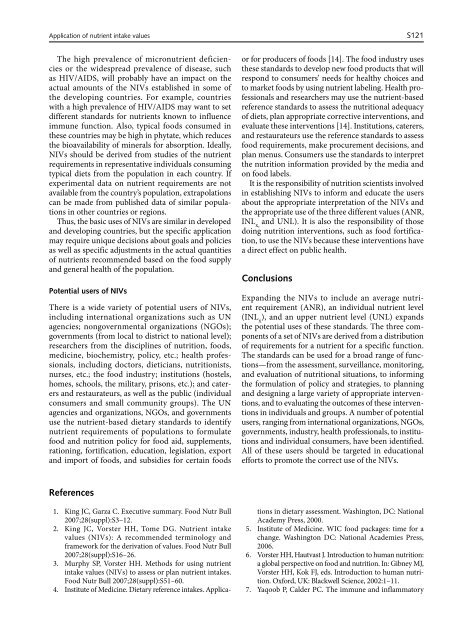Implementing food-based dietary guidelines for - United Nations ...
Implementing food-based dietary guidelines for - United Nations ...
Implementing food-based dietary guidelines for - United Nations ...
You also want an ePaper? Increase the reach of your titles
YUMPU automatically turns print PDFs into web optimized ePapers that Google loves.
Application of nutrient intake values<br />
The high prevalence of micronutrient deficiencies<br />
or the widespread prevalence of disease, such<br />
as HIV/AIDS, will probably have an impact on the<br />
actual amounts of the NIVs established in some of<br />
the developing countries. For example, countries<br />
with a high prevalence of HIV/AIDS may want to set<br />
different standards <strong>for</strong> nutrients known to influence<br />
immune function. Also, typical <strong>food</strong>s consumed in<br />
these countries may be high in phytate, which reduces<br />
the bioavailability of minerals <strong>for</strong> absorption. Ideally,<br />
NIVs should be derived from studies of the nutrient<br />
requirements in representative individuals consuming<br />
typical diets from the population in each country. If<br />
experimental data on nutrient requirements are not<br />
available from the country’s population, extrapolations<br />
can be made from published data of similar populations<br />
in other countries or regions.<br />
Thus, the basic uses of NIVs are similar in developed<br />
and developing countries, but the specific application<br />
may require unique decisions about goals and policies<br />
as well as specific adjustments in the actual quantities<br />
of nutrients recommended <strong>based</strong> on the <strong>food</strong> supply<br />
and general health of the population.<br />
Potential users of NIVs<br />
There is a wide variety of potential users of NIVs,<br />
including international organizations such as UN<br />
agencies; nongovernmental organizations (NGOs);<br />
governments (from local to district to national level);<br />
researchers from the disciplines of nutrition, <strong>food</strong>s,<br />
medicine, biochemistry, policy, etc.; health professionals,<br />
including doctors, dieticians, nutritionists,<br />
nurses, etc.; the <strong>food</strong> industry; institutions (hostels,<br />
homes, schools, the military, prisons, etc.); and caterers<br />
and restaurateurs, as well as the public (individual<br />
consumers and small community groups). The UN<br />
agencies and organizations, NGOs, and governments<br />
use the nutrient-<strong>based</strong> <strong>dietary</strong> standards to identify<br />
nutrient requirements of populations to <strong>for</strong>mulate<br />
<strong>food</strong> and nutrition policy <strong>for</strong> <strong>food</strong> aid, supplements,<br />
rationing, <strong>for</strong>tification, education, legislation, export<br />
and import of <strong>food</strong>s, and subsidies <strong>for</strong> certain <strong>food</strong>s<br />
References<br />
1. King JC, Garza C. Executive summary. Food Nutr Bull<br />
2007;28(suppl):S3–12.<br />
2. King JC, Vorster HH, Tome DG. Nutrient intake<br />
values (NIVs): A recommended terminology and<br />
framework <strong>for</strong> the derivation of values. Food Nutr Bull<br />
2007;28(suppl):S16–26.<br />
3. Murphy SP, Vorster HH. Methods <strong>for</strong> using nutrient<br />
intake values (NIVs) to assess or plan nutrient intakes.<br />
Food Nutr Bull 2007;28(suppl):S51–60.<br />
4. Institute of Medicine. Dietary reference intakes. Applica-<br />
S121<br />
or <strong>for</strong> producers of <strong>food</strong>s [14]. The <strong>food</strong> industry uses<br />
these standards to develop new <strong>food</strong> products that will<br />
respond to consumers’ needs <strong>for</strong> healthy choices and<br />
to market <strong>food</strong>s by using nutrient labeling. Health professionals<br />
and researchers may use the nutrient-<strong>based</strong><br />
reference standards to assess the nutritional adequacy<br />
of diets, plan appropriate corrective interventions, and<br />
evaluate these interventions [14]. Institutions, caterers,<br />
and restaurateurs use the reference standards to assess<br />
<strong>food</strong> requirements, make procurement decisions, and<br />
plan menus. Consumers use the standards to interpret<br />
the nutrition in<strong>for</strong>mation provided by the media and<br />
on <strong>food</strong> labels.<br />
It is the responsibility of nutrition scientists involved<br />
in establishing NIVs to in<strong>for</strong>m and educate the users<br />
about the appropriate interpretation of the NIVs and<br />
the appropriate use of the three different values (ANR,<br />
INL x, and UNL). It is also the responsibility of those<br />
doing nutrition interventions, such as <strong>food</strong> <strong>for</strong>tification,<br />
to use the NIVs because these interventions have<br />
a direct effect on public health.<br />
Conclusions<br />
Expanding the NIVs to include an average nutrient<br />
requirement (ANR), an individual nutrient level<br />
(INL x ), and an upper nutrient level (UNL) expands<br />
the potential uses of these standards. The three components<br />
of a set of NIVs are derived from a distribution<br />
of requirements <strong>for</strong> a nutrient <strong>for</strong> a specific function.<br />
The standards can be used <strong>for</strong> a broad range of functions—from<br />
the assessment, surveillance, monitoring,<br />
and evaluation of nutritional situations, to in<strong>for</strong>ming<br />
the <strong>for</strong>mulation of policy and strategies, to planning<br />
and designing a large variety of appropriate interventions,<br />
and to evaluating the outcomes of these interventions<br />
in individuals and groups. A number of potential<br />
users, ranging from international organizations, NGOs,<br />
governments, industry, health professionals, to institutions<br />
and individual consumers, have been identified.<br />
All of these users should be targeted in educational<br />
ef<strong>for</strong>ts to promote the correct use of the NIVs.<br />
tions in <strong>dietary</strong> assessment. Washington, DC: National<br />
Academy Press, 2000.<br />
5. Institute of Medicine. WIC <strong>food</strong> packages: time <strong>for</strong> a<br />
change. Washington DC: National Academies Press,<br />
2006.<br />
6. Vorster HH, Hautvast J. Introduction to human nutrition:<br />
a global perspective on <strong>food</strong> and nutrition. In: Gibney MJ,<br />
Vorster HH, Kok FJ, eds. Introduction to human nutrition.<br />
Ox<strong>for</strong>d, UK: Blackwell Science, 2002:1–11.<br />
7. Yaqoob P, Calder PC. The immune and inflammatory




